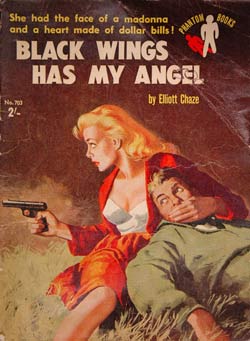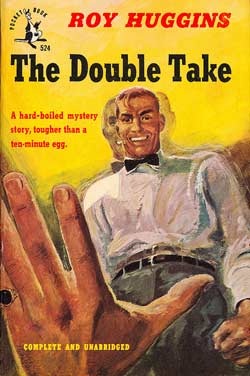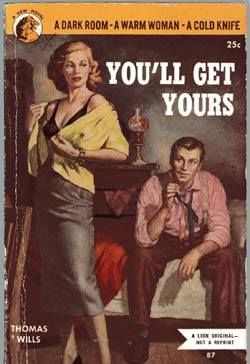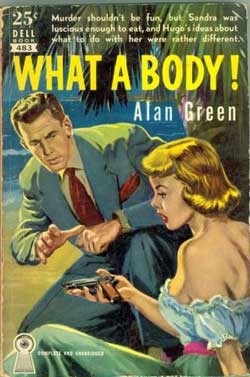 Let’s face it: a book cover is a seduction. No one knew this better than the pulp fiction publishers of the 1940s and ’50s, their covers all gussied up with lurid colors, barely clad women, big black guns, and promises of what was between the covers.
Let’s face it: a book cover is a seduction. No one knew this better than the pulp fiction publishers of the 1940s and ’50s, their covers all gussied up with lurid colors, barely clad women, big black guns, and promises of what was between the covers.
But what’s a seduction without a good pickup line?
Much attention has been paid to those boundary pushing images adorning the 25-cent paperbacks, but I also love the tag lines—that extra copy the publisher adds on to give more of a hint about the action, sex and violence inside a book.
They can be simple, like on The Double Take by Roy Huggins: “A hard-boiled mystery story, tougher than a ten-minute egg.”
They can be mysterious and enticing, such as Stone Cold Dead by Richard Ellington: “Make ready: ONE CORPSE FOR SHARK-BAIT!”
And, yes, they use a lot of exclamation points, but admit it, you want to know why a corpse is needed for shark-bait, don’t you?
By publisher, there wasn’t any set formula for tag lines, unlike the way the artwork sometimes defined an imprint: the graphic style of Dell; the sleazy pictures on a Gold Medal paperback; or the elegant, yet lurid style of Popular Library.
Tag lines do fall into several categories, however. One is what I call “The Come-On”: short, punchy lines that make a bold statement or ask a leading question.
Take for example the clever word play in Murder One by Eleazar Lipsky: “A cold corpse made her a hot bet for the electric chair”
Or the femme fatale  at the heart of Black Wings Has My Angel by Elliott Chaze: “She had the face of a Madonna and a heart made of dollar bills.” My kind of gal.
at the heart of Black Wings Has My Angel by Elliott Chaze: “She had the face of a Madonna and a heart made of dollar bills.” My kind of gal.
A good question always went far, such as Catch a Killer by Ursula Curtiss: “Was it to be MURDER . . .again?”
They didn’t even always have to make a whole heck of a lot of sense, as in The Devil Threw Dice by Amber Dean: “She was the kind of gal that many men might kill” or While Murder Waits by John Esteven: “Night is the time for killing.”
I’m not sure what kind of gal that is, or why night is any better than day for killing, but I guess wanting to know is a good reason to pick up a book.
Another category of tag lines is the “Just The Facts, Ma’am” style of wording, letting you know exactly what you were in for if you crack the spine on this two-bit mystery.
What do you get in Ross MacDonald’s The Way Some People Die? Why, “Dope, Delinquents and MURDER” of course.
How about The Big Heat by William P. McGivern? “A novel of murder, graft, and retribution.” Can’t say they didn’t tell you what you were in for.
Wade Miller’s Killer’s Choice offers “A fast paced mystery of the vice racket.” John Spain’s Dig Me A Grave promises, “A study in violence . . . blackmail . . .and sudden death.”
What do you get when you read Edge of Panic by Henry Kane? “A few drinks with a blonde, and then smashing violence and a blacked-out memory.”
Many of the Just Th e Facts style tag lines resort to a list of adjectives:
e Facts style tag lines resort to a list of adjectives:
Run, Killer, Run by Bill Gault: “Tough, sexy, fast and exciting.”
You’ll Get Yours by Thomas Wills: “A dark room—a warm woman—a cold knife.”
Shakedown by Ben Kerr: “Blackmail . . . a sizzling blonde . . . and suspense.”
Death Commits Bigamy by James M. Fox: “A sensational mystery novel—taut, tense, trigger-fast . . .”
Then there are the “Trust Me” tag lines that carry their own endorsements.
On Earle Basinsky’s The Big Steal, almost as big as the author’s name is this: “Mickey Spillane says: The kind of book I go for.” Well, who’s going to argue with Mick? For the record, it’s the kind of book I go for too. Great read. Find it if you can.
I love this quote on the cover of Bullet Proof by Frank Kane: “Written with the authority of a machine gun” mostly because the quote is attributed to no one. Presumably someone in the office said it so they could quote it and onto the cover it went.
Lest you were confused about what kind of book you were getting if you were looking at Teen-Age Mafia by Wenzell Brown, Gold Medal books reassures you with this on the front cover “Make no mistake about it—these are not punk kids, they’re an organized mob specializing in violence.”
Both Spillane and Richard S. Prather’s Shell Scott novels often resorted to nothing more than telling you how many millions of books the authors had in print. Prather’s sales figures are charted over the course of his publishing career as books touted four, then five, then over six millions Shell Scott books in print. When he did get a real tag line, they were beauts, like the one on Everybody Had A Gun: “Shell Scott knew what he stood to lose—his life. That’s all, brother—his life!”
To Kiss or Kill by Day Keene wants to have it both ways with this one: “The prize fighter’s lady! Or was she? A novel with a K.O. on every page.” A little taste of the book, a little objective commentary.
 Mostly, it’s those lusty “Teasers” we love on the covers of the old pulps. Prather again gets a good one written in the voice of Shell Scott on Take A Murder, Darling: “Man, oh, man, she was slaying me, inch by inch—smile by smile!”
Mostly, it’s those lusty “Teasers” we love on the covers of the old pulps. Prather again gets a good one written in the voice of Shell Scott on Take A Murder, Darling: “Man, oh, man, she was slaying me, inch by inch—smile by smile!”
As pickup lines go, can you beat this one from What A Body! by Alan Green? “Murder shouldn’t be fun, but Sandra was luscious enough to eat, and Hugo’s ideas about what to do with her were rather different.” If they’re as different as that tag line, we’re in for something good.
How about Hell’s Our Destination by Gil Brewer? “Sanity took a backseat while they drove headlong to disaster.”
And one of my personal favorites from No Mourners Present by Frank G. Presnell: “Killer’s don’t cry . . . until they’re caught”
So when Murder Comes Calling (by Malcolm Douglas) you can be sure “There was only one thing in life she couldn’t cheat on—death.”
Or if you’re wondering why Blondes Die Young (by Bill Peters) it’s because she’s got “Time on her hands—men on her mind.”
But don’t cry any Tears For The Bride (by Robert Martin) because “She was lovely and willing . . . but her boyfriends didn’t live long.”
So next time you ogle that tawdry pulp fiction cover, eyes rolling over the sheer fabric on the women, the bruised knuckles on the gunsels, take the time to read a little. That’s why we’re here, right? A lot of the best prose in some of these books is right there on the cover.
Eric Beetner is the author of Dig Two Graves, Split Decision and A Mouth Full Of Blood, as well as co-author (with JB Kohl) of One Too Many Blows To The Head and Borrowed Trouble. His award-winning short stories have appeared in Pulp Ink, D*cked, Grimm Tales, Discount Noir, Off The Record, Murder In The Wind, Needle Magazine, Crimefactory, The Million Writers Award: Best New Online Voices and more. His newest novel, The Devil Doesn’t Want Me is available now. For more info visit ericbeetner.blogspot.com.
Read all posts by Eric Beetner for Criminal Element.

I have read [url=http://www.criminalelement.com/Eric%20Beetner#filter]Eric Beetner[/url]’s “More Than Pretty Pictures: Tag Lines in Classic Pulp Novels” with some alarm.
He has made a common mistake. There was no such thing as “pulp paperbacks. ” Pulps and paperbacks were not the same thing. How can they be the same thing when paperbacks helped put the pulps out of business?
Pulps were magazines, mostly selling for ten cents. Typically, a pulp was 7” by 10” and printed on the cheapest paper, pulp. Thus their name. And outside of the Spicy line, “barely clad women” were rare on the covers of pulps. Additionally, pulp was not a genre!
Rather, pulp HAD genres: mystery/crime, horror, fantasy, science fiction, aviation, war, adventure and masked vigilantes. Those same genres are found in the mass market paperbacks Mr. Beetner is highlighting. Pulp was delivery system. It’s not pulp unless it was in a pulp magazine.
There’s no reason to make mystery and crime fiction synonymous with “pulp” when Western and romance pulps were more popular and longer lived! The Shadow had over 300 issues. And that was twice a month, in fact. The Phantom Detective made it into the early ’50s. Astounding Science Fiction morphed into Analog, so you could say that it still exists.
Anyone who reads one of the novels Mr. Beetner discussing would be sorely disappointed upon reading a Western, romance or Shadow pulp. Want to know what pulp was? Pulp fiction was highly unrealistic. The contents of the books Mr. Beetner is discussing feature adult subject matter and a level of violence you would not find in the pulps. Anyone who is expecting that kind of content in The Shadow orRanch Romances in those books would also be severely disappointed. Crime/mystery fiction, then, has quite a few genres (Westerns, romance, masked vigilantes and science fiction) ahead of it that has just as much, if not, more of a claim to being the poster child for pulp. I would think that a magazine dedicated to publishing would be more aware of publishing’s past!
Lloyd Cooke
The operative word in the article is “novel” not paperback. Pulp novels did exist as many were previously published in serialized form in pulp magazines. Tarzan for example. But pulp magazines were just the DELIVERY system for the fiction we call pulp. They are NOT pulp fiction itself. When a pulp magazine reprints H.G. Wells’ War of the Worlds, it doesn’t make that pulp fiction. And conversely the same type of lurid fiction often written by the SAME people in those magazines either collated in paperback form or in paperback originals, it makes it pulp fiction despite not being in a pulp magazine. It’s not as clear cut as you think.
I am trying to find the value of a Book written by Amber Dean, “Dead Man’s Float” copyright in 1944, a Hillman Publication.